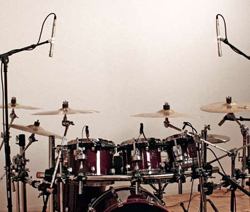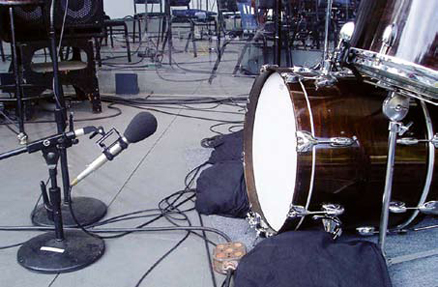
Audience Mics: One of the differences between a pro and an neophyte when it comes to live recording is the type of mics selected for the audience.
A neophyte will use any mics left over after the stage is mic’ed, while a pro will reserve some of his best mics for the job.
Let’s face it, an audience that sounds big and full is so much more exciting than one that sounds small and tinny, and the same goes for the music coming off the stage.
Care & Feeding
Best practice dictates a bit of extra attention and care to keep studio mics working optimally in live applications.
For example, as soon as a show is over, they should be the first thing removed from the stage and put into cases.
It’s too easy to knock over mics and send them crashing to the ground during the mad rush to pack up. Protect those “precious babies” by putting them away first.
Many shock mounts are almost as delicate as the mics they’re coupled with, so be careful not to lose any of the rubber bands or other loose parts.
And always use the recommended shock mount – count on disaster if you try to jury rig a noncompatible mount to an expensive mic.
Care must also be taken to avoid damaging or losing the multipin cable for any mic with an outboard power supply.
There’s no standard cable or wiring, so don’t expect to automatically be able to use one from another mic unless it’s exactly the same model.
Moisture is the biggest enemy of any mic, especially condensers. Try to keep the mics in a controlled temperature so there won’t be any condensation when going from a cold to warm environment.
If you’re packing them inside a cold truck, at least put some packages of silica gel (Figure 1-Page 1) inside the mic box to catch some of the moisture, then allow them to gradually acclimate to room temperature before opening the box.
Hot & Cold
Avoid temperature extremes. These types of mics tend to dislike anything above about 95 degrees and below 50. Also try to keep them out of direct sunlight during the summer (if possible).
Avoid freezing temperatures because any condensation will turn to ice, which is a sure way to disfigure the capsule or ribbon and change the mic’s response. In addition, never spray these mics with a liquid cleaner. Use a soft cloth to clean the outside.
Finally, all ribbon mics, no matter what their makers may claim, have a problem with wind.
Never blow directly into a ribbon mic, don’t put them directly in front of the kick drum unless angled as shown in Figure 2, and even be careful how fast you close the lid on the box.
Further, phantom power can destroy a ribbon if used with a bad cable, so be extra careful before you hit that “+48V” switch.
Following these steps should result in no problems using studio mics on stage, and the upside can be some dramatically improved results.
Bobby Owsinski is a veteran audio professional and the author of several books about live and recorded sound.

